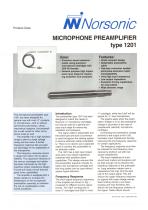
Catalog excerpts

Product Data MICROPHONE PREAMPLIFIER • Precision sound measure- ments using precision microphone cartridges with • General purpose high imped- ance input stage for measur- • Small compact design • Detachable preamplifier • One-size connector system eliminates extension cable • Very high input impedance • Excellent driving capabilities • Wide dynamic range The microphone preamplifier type general use with most W condens- permanent polarisation. Using mechanical adaptors, the preampli- fier is well suited for other micro- phone sizes as well. The amplifier has a high dynamic range to permit a large voltage swing and low noise. A broad frequency response lets you take full advantage of the capabilities of The frequency response covers a range from below 1 Hz to above the various cartridges and cables has been minimised by the high input/low output impedance design. A push-pull output circuit ensures good driver capabilities. The amplifier is equipped with a heater resistor to increase the preamplifier assembly to minimise the risk of condensation under humid conditions. The preamplifier type 1201 has been designed to match the needs of Norsonic Vz" microphone cartridges, pose input stage for measuring The signal cable is detachable and the same type and size of connector is used throughout the cabling system to ensure extension cable compatibili- ty. There is no need to use a separate cable to connect the preamplifier to The 1201 has a high input imped- ance and a low output impedance combined with excellent driver capabilities. This design ensures that the preamplifier presents virtually no load to the microphone cartridge and that long cables can be used without severe signal distortion. Frequency Response The small signal frequency responses (overleaf) for different source capaci- most W cartridges and 50pF to most 1" cartridges, while the 6.4pF will be typical for W size microphones. The graphs apply when the polari- sation voltage is on or the polarisation voltage is grounded in the case of prepolarised (electret) microphone Connecting the polarisation voltage increases input impedances thereby improving the low-frequency response The frequency response must then be checked for low-frequency reso- nances by testing it out with real source impedances. The input impedance of most sound level meters and analysers will be high enough not to influence the frequency response of the preamplifi- er. Long extension cables have a capacitance that may limit the slew rate of the output signal. This will reduce the upper frequency response for signals with large voltage swings. Such limiting will be a non-linear process and may therefore also disturb the low frequency contents of the signal. Cable effects should
Open the catalog to page 1
always be considered when long To minimise such problems, the type 1201 has been designed with high efficiency driver capabilities. However, the power supply feeding the preamplifier will in most cases set the practical limit. The maximum upper frequency as a function of cable length has been tabulated in Table 1. Noise Considerations Fig. 2 shows a typical frequency spectrum of the preamplifier's inherent noise in one-third octave bands for a transducer impedance of 18pF. Note that a real microphone cartridge has resistive impedance components in classic theory describes, resistive...
Open the catalog to page 2All Norsonic AS catalogs and technical brochures
-
Product Range Catalogue
36 Pages
-
Nor1216 /Nor1217
4 Pages
-
Nor1210A and Nor1210C
2 Pages
-
Nor1209
2 Pages
-
Nor1207 and Nor1207/BNC
2 Pages
-
Microphone Cartridges
2 Pages
-
Nor1292
2 Pages
-
Nor1530 Compact NMT
4 Pages
-
Nor277 Tapping machine
2 Pages
-
Acoustic Camera
8 Pages
-
Audiometer-Calibration Kit
1 Pages
-
Measuring Noise
2 Pages
-
Nor131 & Nor132
8 Pages
-
Nor 121
12 Pages
-
Nor 140
20 Pages
-
noise at work Nor 130
2 Pages
-
Noise excitation for BA
8 Pages
-
Sound Calibrators
4 Pages
-
Microphone Cartridges
2 Pages
-
Nor 130
8 Pages
-
Nor850 Product Data English
8 Pages
-
Product Range Catalogue 2011
52 Pages
































